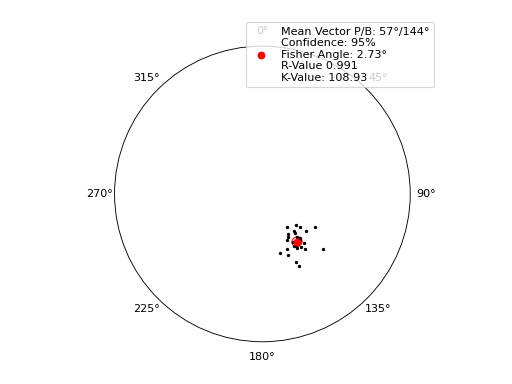fisher_stats.py¶
This example shows how the Fisher statistics can be computed and displayed.
Based on example 5.21 and example 5.23 in [Fisher1993].
| Data in: | Table B2 | (page 279) |
| Mean Vector: | 144.2/57.2 | (page 130) |
| K-Value: | 109 | (page 130) |
| Fisher-Angle: | 2.7 deg. | (page 132) |
Reference¶
| [Fisher1993] | Fisher, N.I., Lewis, T., Embleton, B.J.J. (1993) “Statistical Analysis of Spherical Data” |
import matplotlib.pyplot as plt
import mplstereonet as mpl
decl = [122.5, 130.5, 132.5, 148.5, 140.0, 133.0, 157.5, 153.0, 140.0, 147.5,
142.0, 163.5, 141.0, 156.0, 139.5, 153.5, 151.5, 147.5, 141.0, 143.5,
131.5, 147.5, 147.0, 149.0, 144.0, 139.5]
incl = [55.5, 58.0, 44.0, 56.0, 63.0, 64.5, 53.0, 44.5, 61.5, 54.5, 51.0, 56.0,
59.5, 56.5, 54.0, 47.5, 61.0, 58.5, 57.0, 67.5, 62.5, 63.5, 55.5, 62.0,
53.5, 58.0]
confidence = 95
fig = plt.figure()
ax = fig.add_subplot(111, projection='stereonet')
ax.line(incl, decl, color="black", markersize=2)
vector, stats = mpl.find_fisher_stats(incl, decl, conf=confidence)
template = (u"Mean Vector P/B: {plunge:0.0f}\u00B0/{bearing:0.0f}\u00B0\n"
"Confidence: {conf}%\n"
u"Fisher Angle: {fisher:0.2f}\u00B0\n"
u"R-Value {r:0.3f}\n"
"K-Value: {k:0.2f}")
label = template.format(plunge=vector[0], bearing=vector[1], conf=confidence,
r=stats[0], fisher=stats[1], k=stats[2])
ax.line(vector[0], vector[1], color="red", label=label)
ax.cone(vector[0], vector[1], stats[1], facecolor="None", edgecolor="red")
ax.legend(bbox_to_anchor=(1.1, 1.1), numpoints=1)
plt.show()
Result¶
